Bodnant Garden Water and Flood Management (2017)
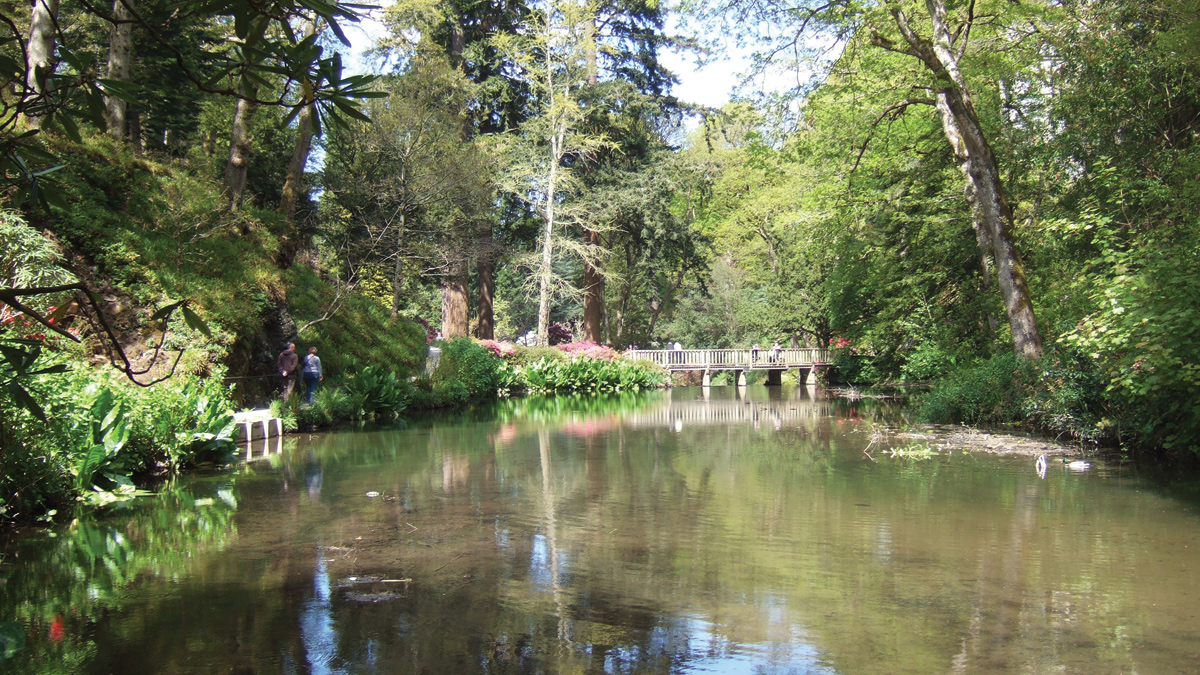
Looking down the Afon Hiraethlyn towards the Waterfall Bridge - Courtesy of Waterco Consultants
National Trust’s 32ha (80 acre) property at Bodnant Garden in North Wales hosts over 225,000 visitors a year and the numbers continue to increase. The historic Grade I listed gardens are famous for the earliest and grandest laburnum arch, five national collections and UK Champion trees. Flooding has repeatedly caused damage to the paths and washed away plants, particularly in December 2015. Repair work has focused on resilient materials and some bridges have been raised. Now, as the first part of a Water Management Plan (WMP), a scoping study has been carried out to ensure a realistic resilient strategy is put in place to minimise and manage the effects of future flooding.
Introduction
Water is a key part of the landscape at Bodnant Gardens. A stream flows through the upper part of the site and joins the River Hiraethlyn in the valley. The paths through the gardens cross the watercourse in about twenty places and there are five weirs or waterfalls contributing to the visitors’ experience.
As well as the river features, there are formal water features in the terraced north gardens. Their water source is a reservoir above the site but the water supply and quality is variable and there have been problems with algae and weeds. Irrigation water and potable water supply and demand for present and future are also included in the scoping study.
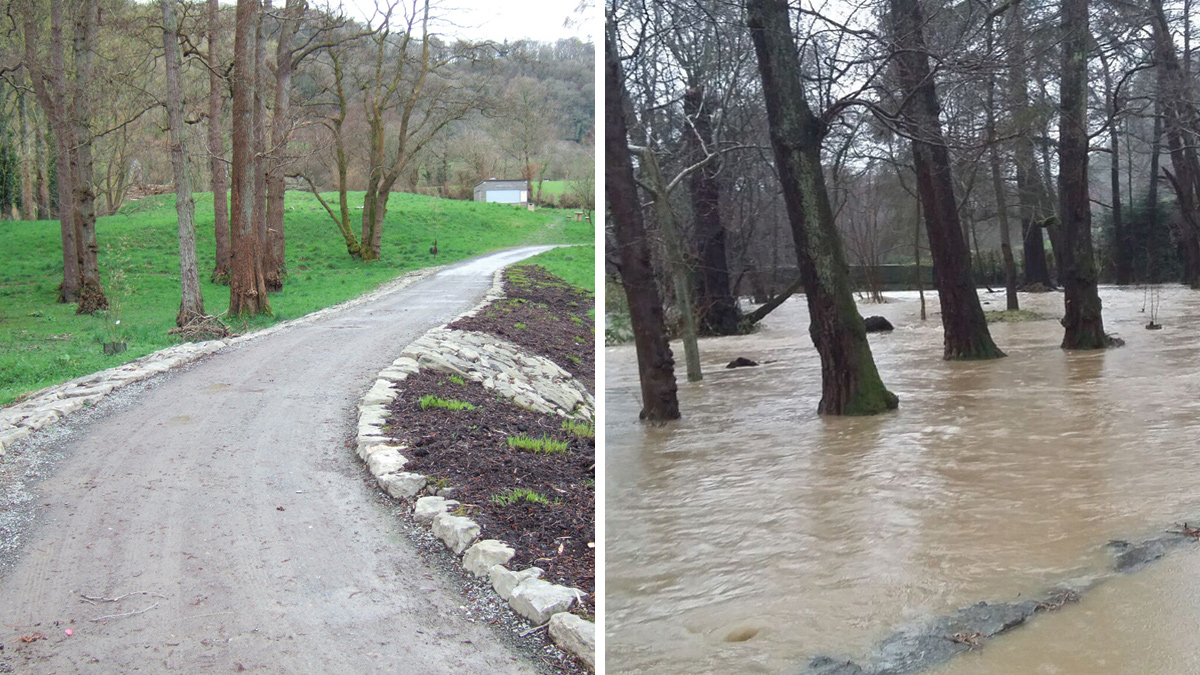
Flooding
The River (Afon in Welsh) Hiraethlyn flows through the gardens and is a key attraction for visitors. The catchment is relatively steep and responds quickly to rainfall. Whilst the Estate House is not at risk of flooding from the Hiraethlyn, past flood events have led to significant damage to the gardens. The major December 2015 flood event deposited several hundred tonnes of river gravels and sediments in the gardens and damaged footpaths and bridges. Significant costs were incurred in remediating the damage and ensuring the gardens remained safe for visitors.
The WMP will investigate and prioritise options to improve the garden’s resilience to flooding, including mapping the most vulnerable areas and managing the movement of water through the off-line lakes in the gardens. Gravel deposition is exacerbated by the historic weirs and cascades along the Hiraethlyn. Improved facilities for managing this risk will be explored, potentially including working with key external stakeholders to ensure future removal work can be undertaken efficiently and with minimum disruption to both the garden and the environment.
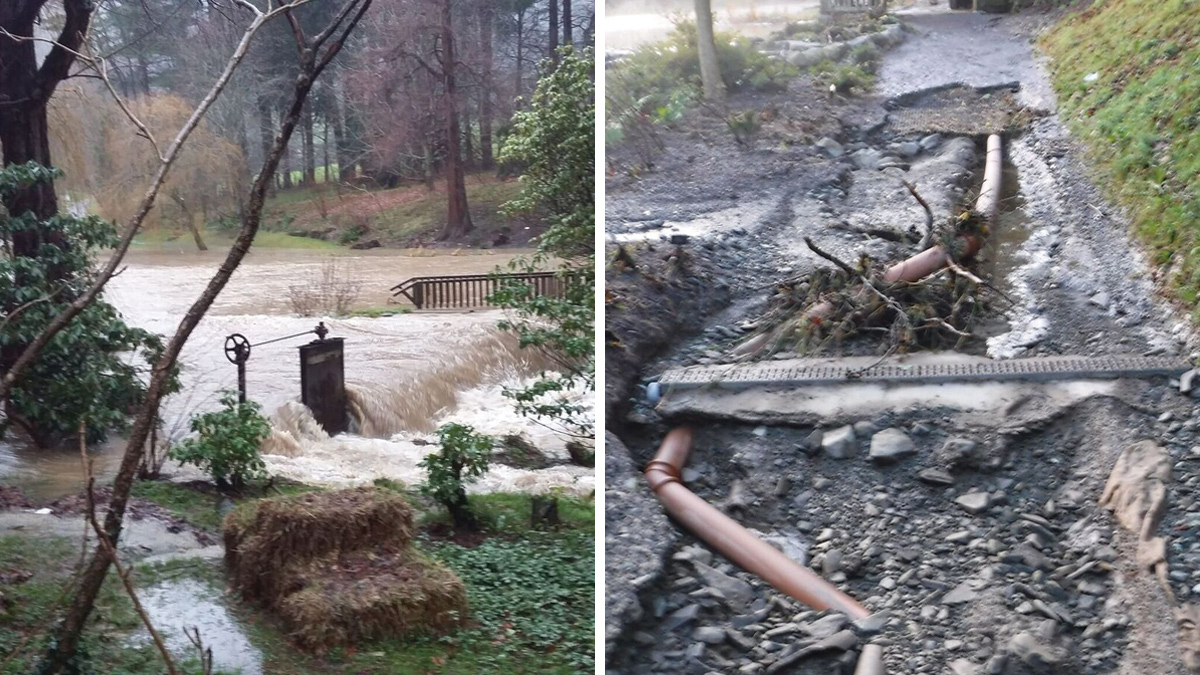 (left) December 2015 flood event. A system of weirs, sluices and stop-logs in the foreground are currently used to regulate water levels in the Skating Pond lake behind the main river channel and (right) damage to garden infrastructure following the December 2015 flood – Courtesy of National Trust
(left) December 2015 flood event. A system of weirs, sluices and stop-logs in the foreground are currently used to regulate water levels in the Skating Pond lake behind the main river channel and (right) damage to garden infrastructure following the December 2015 flood – Courtesy of National Trust
The financial damages from flooding are not sufficient to justify a traditional flood risk management scheme, such as an upstream storage reservoir. However, natural flood management (NFM) approaches have the potential to reduce runoff rates in the catchment and could offer an exciting opportunity to reduce risk to Bodnant Garden and potentially upstream villages.
These would focus on overflow routes and managing sediment and gravel transport and removal. The successful implementation of NFM would necessitate buy-in from a wide range of stakeholders in the catchment and a long-term strategy is likely to be required to realise significant benefits. However, potential opportunities to implement NFM measures and reduce surface water runoff and sediment erosion within the estate may exist. These opportunities, and potentially the wider use of NFM, will be explored via the WMP.
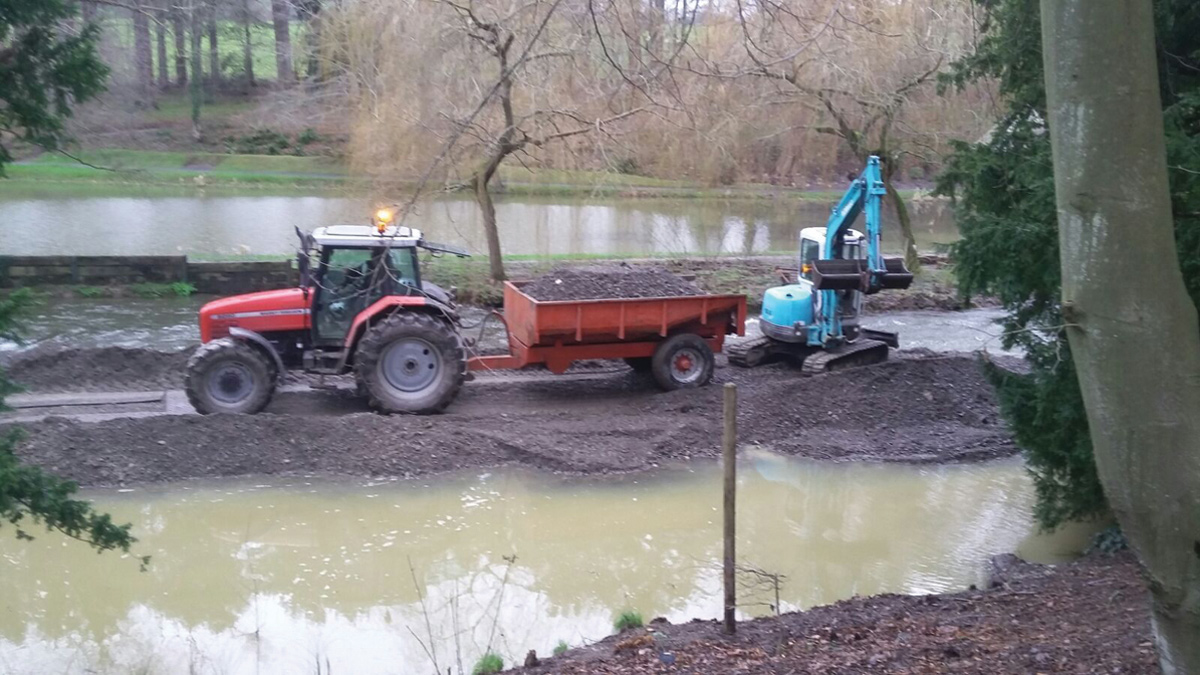 Gravel removal works following the major December 2015 flood event – Courtesy of National Trust
Gravel removal works following the major December 2015 flood event – Courtesy of National Trust
Natural Flood Management
Recent policy changes, including the European Union Water Framework Directive (WFD) have encouraged more natural approaches to flood management to create sustainable solutions in light of directives to improve the environment and of climate change’s impact on the hydrological cycle.
Significant action needs to be taken in order to protect the world’s population from riverine and coastal flooding and it is not economically viable to reinforce the entire network of existing flood defences.
The traditional approach to flood risk management, involving engineering solutions such as enlarged culverts and raised defences, is changing. Research suggests that a natural catchment approach to flood management is environmentally, socially and economically beneficial.
Natural Flood Management involves strategic tree planting (to create shelter belts) and the reintroduction of waterway storage to attenuate flows, reduce peak runoff and improve water quality.
There are many options to choose from to increase the resilience of an area to flooding. A combination of both traditional hard engineering and newer more sustainable and natural techniques are seen to be effective at attenuating flows and reducing the impact of flood events.
Land use changes have amplified the impact and economical loss following a flood event. However, inundation of the floodplain is a natural hydraulic process crucial to the biodiversity and biogeochemical processes of the natural environment, along with the natural management of the river during extreme flows.
National policy and guidance are changing the chosen flood management approaches to more sustainable and catchment based approaches for multiple benefits. The main drivers are to not only prevent the degradation of rivers and their catchments but to address environmental concerns collectively, one of which being to improve flood resilience.
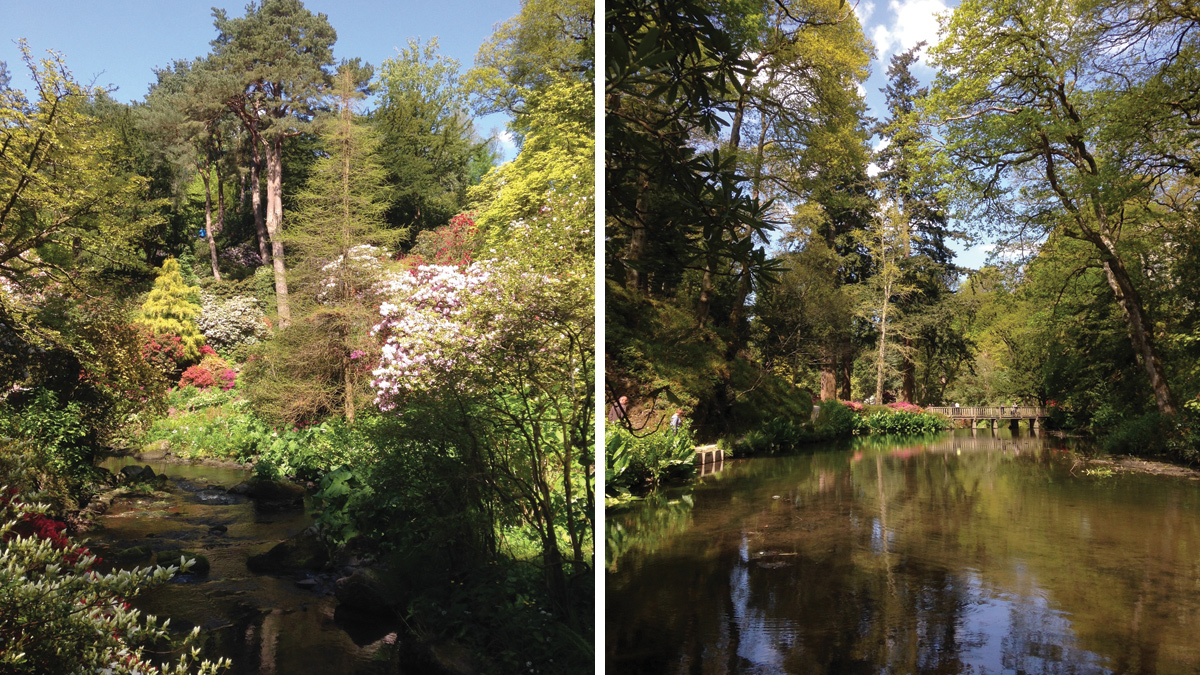 (left) Bodnant Garden and (right) looking down the Afon Hiraethlyn towards the Waterfall Bridge. Large quantities of gravel are deposited in the slow-moving river channel upstream of the ornamental cascade – Courtesy of Waterco Consultants
(left) Bodnant Garden and (right) looking down the Afon Hiraethlyn towards the Waterfall Bridge. Large quantities of gravel are deposited in the slow-moving river channel upstream of the ornamental cascade – Courtesy of Waterco Consultants
Water features and irrigation
Existing water supplies for the ornamental ponds and for irrigation are the Clwt Reservoir and the river Hiraethlyn. The pumps in the old mill building alongside the river are no longer operable. They were used to top up the reservoir with river water as required.
The cast iron main from the pump to the reservoir is thought to be in poor condition and the exact route is unknown. The reservoir level is therefore reliant on overland flow, which is variable. The current reservoir system is deficient in that the site cannot be easily irrigated and the water supplied is high in nutrients believed to promote alga blooms and growth in the ornamental ponds.
A solution to the issues surrounding the reservoir water and the supply/ distribution system to and from the reservoir is to investigate a new borehole or well within the grounds. This would provide reliable availability and quality for the ornamental water features. A dedicated supply main to provide water to key points would also be required.
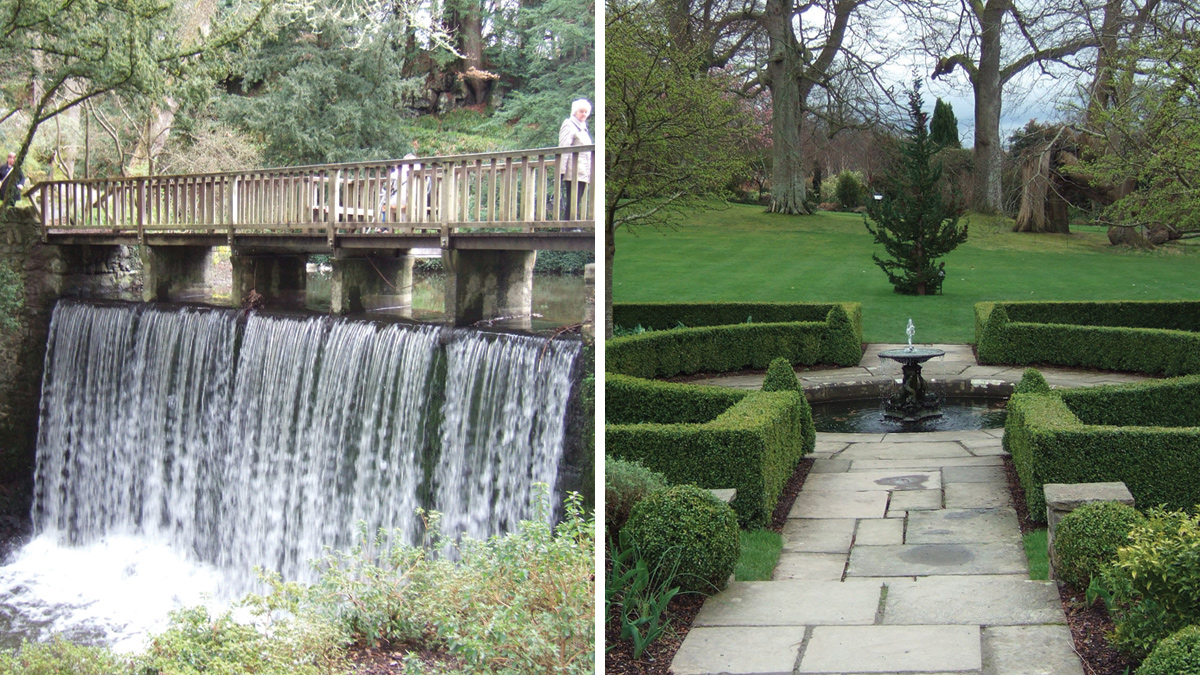 (left) The Waterfall Bridge and (right) Ornamental garden – Courtesy of Waterco Consultants
(left) The Waterfall Bridge and (right) Ornamental garden – Courtesy of Waterco Consultants
Potable water supplies
There are currently three metered potable water supplies from the water mains supplying the buildings. Although usage records are available, comprehensive plans showing the routes and connectivity of these water supplies are not available.
Tracing and proving the existing systems to confirm mains directions and areas fed will be beneficial to the WMP. The results would be plotted on a topographical/OS survey background. Trial holes could confirm location, material and condition of the existing pipes.
A new potable water supply is also being considered to support further development for visitor services at the southern end of the garden.
Next steps and conclusions
The first deliverable from the Water Management Plan is a scoping report, designed to identify the water management measures that could potentially bring benefit to the estate.
 Bodnant Garden – Courtesy of Waterco Consultants
Bodnant Garden – Courtesy of Waterco Consultants
Key features include:
- Cost-effective gravel and flood management.
- Installation of a borehole.
- Water supply mapping for potable and irrigation water.
- Additional potable water supply.
Working closely with the National Trust, this scoping report will be developed into a prioritised and costed action plan. This will give the National Trust a valuable toolkit of options to enable them to programme water management works over the years to come.



